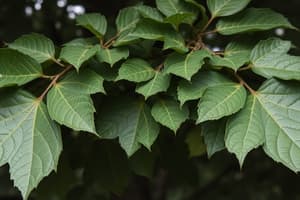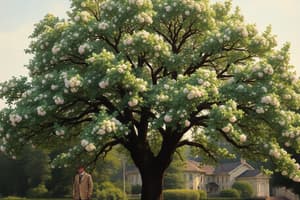Podcast
Questions and Answers
What is a primary function of tree roots?
What is a primary function of tree roots?
- To produce leaves
- To generate energy through photosynthesis
- To anchor the tree and absorb nutrients (correct)
- To support the tree canopy
Which type of trees typically lose their leaves seasonally?
Which type of trees typically lose their leaves seasonally?
- Coniferous trees
- Tropical trees
- Broadleaf trees
- Deciduous trees (correct)
What layer of tissue is responsible for the secondary growth in trees?
What layer of tissue is responsible for the secondary growth in trees?
- Xylem
- Phloem
- Cambium (correct)
- Meristem
Which of the following ecosystems are trees particularly important for regulating climate?
Which of the following ecosystems are trees particularly important for regulating climate?
Which characteristic is typical for coniferous trees?
Which characteristic is typical for coniferous trees?
How does tree growth rate vary?
How does tree growth rate vary?
What ecological role do trees serve by absorbing rain and releasing water vapor?
What ecological role do trees serve by absorbing rain and releasing water vapor?
Which of the following is a direct threat to trees?
Which of the following is a direct threat to trees?
What is one of the main contributions trees make to their ecosystems?
What is one of the main contributions trees make to their ecosystems?
Which part of the tree primarily captures energy from sunlight for photosynthesis?
Which part of the tree primarily captures energy from sunlight for photosynthesis?
Flashcards
Tree Growth
Tree Growth
Trees are living organisms that grow continuously throughout their lifespan, adding wood and expanding their branches.
Tree Functions
Tree Functions
Trees play a vital role in ecosystems by providing habitats for wildlife, absorbing carbon dioxide, and preventing soil erosion.
Vascular Cambium
Vascular Cambium
The specialized layer of tissue in trees that produces new wood cells, leading to an increase in girth.
Deciduous Trees
Deciduous Trees
Signup and view all the flashcards
Roots
Roots
Signup and view all the flashcards
Coniferous Trees
Coniferous Trees
Signup and view all the flashcards
Trunk
Trunk
Signup and view all the flashcards
Broadleaf Trees
Broadleaf Trees
Signup and view all the flashcards
Tropical Trees
Tropical Trees
Signup and view all the flashcards
Deforestation
Deforestation
Signup and view all the flashcards
Study Notes
General characteristics
- Trees are perennial woody plants with a single, dominant trunk or stem
- Mature trees typically have a well-defined crown of branches and leaves
- Trees exhibit secondary growth, meaning they increase in girth throughout their lifespan
- This growth is due to the activity of vascular cambium, a layer of meristematic tissue
Types of Trees
- Deciduous trees: Lose their leaves seasonally, typically in the fall or winter
- Coniferous trees: Possess needle-like or scale-like leaves and usually produce cones
- Examples include pines, spruces, and firs
- Broadleaf trees: Typically have broad, flat leaves
- Examples include oaks, maples, and beeches
- Tropical trees: Grow in tropical regions, characterized by high temperatures and abundant rainfall; also often evergreen
- Temperate trees: Grow in temperate regions, with varying seasons and temperatures
Tree Structure
- Roots: Primarily function to anchor the tree in the ground and absorb water and nutrients from the soil
- Fibrous roots spread widely, while taproots descend deeply
- Trunk: Supports the canopy and transport water and nutrients throughout the tree
- Branches: Provide support for leaves and other parts of the tree, as well as enabling the better distribution of the canopy for sunlight collection
- Leaves: Primary sites of photosynthesis, capturing energy from sunlight to produce food
- Leaves exhibit various shapes and sizes depending on the species and environment
Tree Growth
- Trees grow continuously throughout their lives, accumulating wood and expanding their branches
- Growth rate varies significantly based on species, climate, and soil conditions
- Environmental factors such as sunlight, water, and nutrient availability play a crucial role in tree growth
- Some trees can live for hundreds or even thousands of years
Tree Functions
- Important ecological roles
- Provide habitat for wildlife
- Absorb carbon dioxide from the atmosphere, contributing to climate regulation
- Prevent soil erosion
Tree Importance in Ecosystems
- Contribute significantly to biodiversity of the ecosystem
- Maintain water cycles by absorbing rain and releasing water vapor into the atmosphere
- Shade ground cover, and create a microclimate within their surrounding environment
- Influence the composition and structure of the forest floor and understory vegetation
- Provide resources for animals including nuts, fruits, and shelter
Threats to Trees
- Deforestation: Clearing of forests for agriculture, urban development, or logging. A major cause of biodiversity loss and habitat destruction
- Disease: Infections and stress disorders affect trees
- Pests: Insects, fungi, and pathogens can severely damage or kill trees
Tree Identification
- Characteristics used for identification include: leaf shape, leaf arrangement, bark patterns, and flower/fruit characteristics
- Identifying trees is important for conservation efforts and management of forests
- Field guides and online resources are available to aid tree identification
Studying That Suits You
Use AI to generate personalized quizzes and flashcards to suit your learning preferences.




